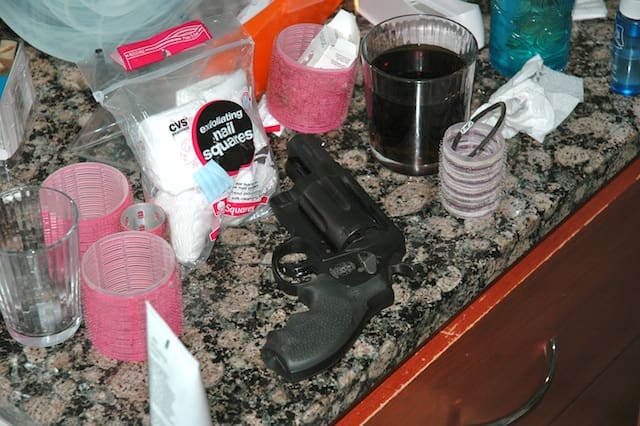 [The following article was written by attorney Lisa J. Steele for nacdl.org. It’s republished here with the author’s permission. Click here for part 1.]
[The following article was written by attorney Lisa J. Steele for nacdl.org. It’s republished here with the author’s permission. Click here for part 1.]
Was the Client’s Belief Reasonable?
“[D]etached reflection cannot be demanded in the presence of a knife.”
– Brown v. United States,
256 U.S. 335, 343, 41 S.Ct. 501, 65 L.E.2d 961 (1921).
What is Reasonable?
Most states employ a subjective and objective test for reasonableness. Once the attorney has analyzed the witness’ testimony and the experts’ reports and developed a theory about the facts in the incident, he or she can begin to develop a theory about the client’s intent and why his or her conduct was objectively reasonable.
The AOJ Triad
Reasonableness can be hard to quantify. The attorney may wish to look at the factors self-defense trainers teach their students. Self-defense trainers refer to adversaries or aggressors who have the ability and opportunity to cause harm, and reasonable people who, observing the aggressive conduct, believe they are in immediate jeopardy of death or serious injury. Essentially, these factors (called the AOJ triad) restate the common law of self-defense.
Ability means the aggressor has the capacity to kill or seriously injure the defender. The attorney should ask the jury to consider relative age, strength, gender, training, level of aggressiveness, weapons, number of aggressors versus number of defenders, etc.
Opportunity means the aggressor is in a position to use his ability. Look at distance, obstacles between the aggressor and defender, cover, and escape routes. An aggressor armed with a firearm has a greater opportunity to harm a defender at range than one armed with a baseball bat.
Jeopardy means that the aggressor’s behavior would lead the defender, and a reasonable observer, to conclude the defender is in imminent danger. Look to threats, gestures, and sudden movement towards the defender. Also consider the defender’s age, fitness, and health. If the defender was injured or was unable to flee due to ill health or disability, he or she might have been in jeopardy earlier than a healthy or uninjured person.
Experts who train civilians (non-police officers) also include a fourth factor — preclusion. The defender must be precluded from retreating in complete safety. (See “Duty to Retreat” below.)
In questioning the client, the attorney is not looking for the client’s conclusion that he was in danger from the aggressor. Instead, the attorney is looking for the observations that led the client to that conclusion. What did the aggressor say and do that showed he or she was dangerous? Members of the jury should come to see the situation as it appeared to the client. They should come to the conclusion that the aggressor intended to seriously injure or kill the client, and that there was no option other than the use of deadly force.
When presenting the client’s subjective intent, the attorney should address any post-incident behavior such as flight or initial denial that the prosecutor may argue exhibits consciousness of guilt. Clients involved in shootings often feel guilty, even when they acted appropriately.
The client may also experience one or more effects of “Post Shooting Trauma” including nightmares, sleep disturbance, social withdrawal, and various personality changes.16 If the client is being psychologically evaluated for competence, the attorney should make sure the expert involved in the evaluation (1) is familiar with the studies on police officer responses in the aftermath of shootings, and (2) considers whether the client is having a similar response.
Would a Reasonable Person Believe the Client Was In Imminent Danger?
“The question of whether a man has reason to apprehend danger from an attack must depend in some measure upon the size and strength of the assailant. . . . [I]t may be shown that he is armed by nature with a superior size and strength, which makes his attack irresistible and dangerous.”
— Com. v. Barnacle,
134 Mass. 215, 216 (1883).
If deadly force was used, the client will only succeed in a self-defense claim if he or she believed there was imminent danger of death or serious bodily harm.
The relative height, weight, and build of the client and the aggressor are important. If the weight and build of the client and a living aggressor have significantly changed, make sure that the attorney establishes this on the record. If the aggressor is deceased, the attorney may want to have an investigator of similar size and build present to show the jury what the client saw facing him or her.
The attorney needs to establish that the danger was imminent. Insults do not pose a danger. Threats, even credible ones, do not constitute an immediate danger. Claiming to have a weapon is not an imminent danger. In addition, there is no imminent danger if the aggressor starts to get a weapon from his house or car. (The client should not stand his or her ground; call the police and seek safety.) However, drawing a weapon creates an imminent danger.
A more common problem arises when the client says he saw the aggressor reaching for a weapon, but no weapon was found. One possibility is that there was no weapon. If the client is looking the aggressor in the eye, and waits until the aggressor completes a sudden movement to see if the object in hand is a firearm or just a wallet, he could be shot at least twice before he can fire in response. The client cannot afford to wait to be certain. An untrained aggressor with a handgun in his waistband can draw the handgun, bring it to eye level, and fire in one-tenth of a second. A trained police officer, his service handgun already drawn, pointed at the aggressor, and with his finger on the trigger, needs an average of .30 seconds to recognize the threat and fire.
The other possibility is that there was a weapon which was not recovered. Look at the time interval between the incident and the first police response to the scene. Look at how the responding police officers described the scene. Were there many people there? Were there friends of the deceased present? Is it possible that someone removed the deceased’s weapon before police arrived? Did police check the deceased’s hands for gunpowder residue?21 Are there any bullet holes or casings that did not come from the client’s firearm? Does the client have any injuries or defensive wounds?
If it becomes clear that the aggressor was not armed and the client knew it, or a reasonable person would have realized it, the client who has used deadly force may still be entitled to a self-defense instruction. “While weapons may be used to inflict [great bodily harm], it is often the case that an opponent who is physically large, powerful, or skilled at fighting will inflict great bodily harm upon a weaker adversary.”
Evidence About the Aggressor’s Character and Threats
Testimony about the aggressor’s character and threats that were known to the client before the incident is generally admissible, and need not be admitted through the client’s testimony. In many states the aggressor’s reputation for violence may be admissible, even if it was unknown to the client, to show that the complainant was the first aggressor.
Threats against the client which he or she does not know about may also be admissible to show that the person hurt or killed was actually attempting to carry out his threat.
The attorney needs to be careful how he or she impeaches the character of the aggressor. Attacking the deceased or injured can backfire. Courts are not sympathetic to the “he needed killing” theory of self-defense, although it may be a viable tactic with some juries.
[Click here for PRT 1. Click here for Part 4]




We covered almost all these points during our concealed weapons class last week, and our instructor told us that we better do everything possible before shooting anyone. One great point he made was about carrying OC sprays, because if you have a problem just spray and use your gun as a last resort. It’s a lot easier to explain why you had to spray someone instead of shooting them.
This is a good series of articles. And JOE, even if the law was different, I’d prefer not killing someone if I could avoid it, but I don’t like pepper spray. It goes everywhere including backward into the user’s face.
Not to get off topic, but WTF are “exfoliating nail squares?” And why is that Smith & Wesson muzzling them?
If you have to ask you need them. And it’s nuzzling, not muzzling.
I never cared for sprays before the class, and the instructor mentioned how you may spray yourself. I don’t ever want to shoot anyone either, but I’m now considering sprays for situations where I might avoid using the gun. I’ve never had to use a gun or spray before and hopefully I never will, but it’s nice to have another option. I think Ralph’s correct, because it looks like that S&W muzzling and not nuzzling.
If you want to greatly reduce the chance of getting OC Spray on yourself you might want to consider some of the Kimber products that use a small pyrotechnic charge to propel the OC at either 90 mph or 270 mph depending on the model. Another advantage is that you get greater range than with the vast majority of sprays.
They are expensive, but worth it IMHO
NukemJim
PS I have no financial interest in the above product or company merely mentioning a product that I found worthwhile. NJ
The gist that I take away from this series of articles is that, if at any time you ever fire your gun in self defense, you will be strung up and crucified…and if you survive, you will end up in jail.
You’re on the right track Toten, I came away with that feeling after completing the concealed weapons class. You better be 110% sure of what you’re doing if you pull a gun on someone, because your life will change forever.
It all depends on where you reside.
Where I live in Colorado our law states “any occupant of a dwelling is justified in using any degree of physical force, including deadly physical force, against another person when that other person has made an unlawful entry into the dwelling, and when the occupant has a reasonable belief that such other person has committed a crime in the dwelling in addition to the uninvited entry, or is committing or intends to commit a crime against a person or property in addition to the uninvited entry, and when the occupant reasonably believes that such other person might use any physical force, no matter how slight, against any occupant.”
It also makes you immune to civil liability if it was self-defense.
Sprays are generally used by police only when they’ve got another officer backing them up with a drawn firearm. A percentage of the public, or drunks or some drugies are unaffected by spray. The extended time required between spraying and drawing your firearm, if the spray doesn’t halt the aggressor, may get you killed. A prosecutor may use the action of first spraying against you, “If you were in fear for your life, why did you first use an ineffective spray?” I carry a gun, but no spray.
Comments are closed.